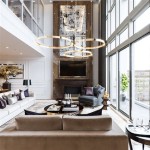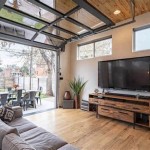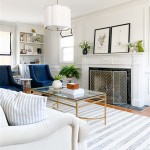Popular Living Room Wall Colors: A Comprehensive Guide
The living room, often considered the heart of a home, serves as a central gathering space for families and a welcoming area for guests. Its design, particularly the color of its walls, profoundly impacts the room's ambiance and overall aesthetic. Choosing the right color palette is a crucial decision that requires careful consideration of various factors, including the room's size, lighting, existing furniture, and personal preferences. This article offers a comprehensive guide to popular living room wall colors, exploring their characteristics and suitability for different living spaces.
Neutral Tones: Versatility and Timeless Appeal
Neutral colors, encompassing shades such as white, beige, gray, and greige (a blend of gray and beige), provide a versatile foundation for any living room design. Their inherent adaptability allows them to seamlessly integrate with a wide range of furniture styles, accent colors, and decorative elements. Neutral tones create a calming and inviting atmosphere, making them ideal for both large and small living rooms.
White: White walls offer a clean, crisp, and airy feel, creating an illusion of spaciousness. They reflect light effectively, making the room appear brighter and more open. White serves as a blank canvas, allowing homeowners to express their personal style through furniture, artwork, and accessories. However, it is important to consider the undertones of white paint, as some whites may lean towards cool (blue or gray undertones) while others lean towards warm (yellow or beige undertones). Choosing the right white with the appropriate undertone will complement the existing furnishings and lighting effectively.
Beige: Beige is a warm and inviting neutral that provides a soft and comfortable backdrop for a variety of design schemes. Unlike stark white, beige offers a touch of warmth and depth, creating a cozy atmosphere. It pairs well with natural materials like wood and stone, making it a popular choice for traditional and transitional living rooms. Similar to white, beige also features various undertones, ranging from creamy yellows to subtle pinks. Selecting a beige that harmonizes with the existing color palette is essential.
Gray: Gray has emerged as a sophisticated and modern neutral, offering a cooler alternative to beige. It provides a versatile backdrop for both contemporary and traditional designs. Gray walls can create a sense of serenity and elegance, particularly when paired with metallic accents and pops of color. Like other neutrals, gray has diverse undertones, including blue, green, and purple. A careful assessment of the room's lighting and existing decor will help determine the most suitable shade of gray.
Greige: Greige, a harmonious blend of gray and beige, offers the best of both worlds. It combines the warmth of beige with the coolness of gray, creating a versatile neutral that complements a wide range of styles. Greige walls provide a sophisticated and calming backdrop, and they work well in both warm and cool lighting conditions. This color is particularly effective in spaces with a mix of warm and cool-toned furniture and accessories.
Warm Colors: Creating a Cozy and Inviting Ambiance
Warm colors, such as reds, oranges, and yellows, evoke feelings of warmth, energy, and optimism. They can create a cozy and inviting ambiance, making them ideal for living rooms where comfort and relaxation are paramount. However, it's crucial to use warm colors judiciously, as they can sometimes overwhelm a space if used excessively. Employing softer shades and balancing them with cooler tones can create a harmonious and balanced effect.
Terracotta: Terracotta, a reddish-brown hue reminiscent of sun-baked earth, brings a sense of rustic charm and natural warmth to a living room. It pairs well with natural materials, such as wood and leather, creating a cozy and inviting atmosphere. Terracotta is particularly well-suited for Mediterranean or Southwestern-inspired design schemes. The color can vary in intensity, ranging from light, earthy tones to deeper, richer hues. A lighter terracotta can brighten a space, while a darker shade can add depth and drama.
Mustard Yellow: Mustard yellow, a sophisticated and muted shade of yellow, adds a touch of warmth and personality to a living room without being overly bright or garish. It pairs well with neutral tones like gray and white, as well as with bolder colors like navy blue and emerald green. Mustard yellow can be incorporated as an accent wall or used throughout an entire room, depending on the desired effect. Its unique character makes it a suitable colour for vintage and eclectic design styles.
Warm Gray with Brown Undertones: While gray is often considered a neutral, certain shades of gray with prominent brown undertones can evoke a warm and inviting feeling. These grays offer a sophisticated alternative to beige, providing a touch of modernity while maintaining a cozy atmosphere. They work well with both warm and cool accents, making them a versatile choice for a variety of design styles.
Cool Colors: Promoting Relaxation and Serenity
Cool colors, including blues, greens, and purples, evoke feelings of calmness, serenity, and tranquility. They can create a relaxing and refreshing atmosphere, making them ideal for living rooms designed for unwinding and socializing. Cool colors can also make a room appear larger and more spacious. Similar to warm colors, balance is key when using cool tones. Pairing them with warmer accents and textures can prevent the space from feeling cold or sterile.
Sage Green: Sage green, a muted and earthy shade of green, brings a sense of nature and tranquility to a living room. It creates a calming and relaxing atmosphere, making it ideal for spaces intended for relaxation and rejuvenation. Sage green pairs well with natural materials like wood and linen, as well as with neutral tones like white and beige. It is a particularly effective color for creating a biophilic design, connecting the interior space with the outdoors.
Light Blue: Light blue, a classic and timeless choice, evokes feelings of serenity and openness. It creates a calming and refreshing atmosphere, making it ideal for living rooms. Light blue pairs well with white, gray, and other neutral tones, as well as with pops of color like coral or yellow. It can be used to create a coastal or nautical-inspired design, or simply to add a touch of tranquility to any space. The shade of light blue can vary, ranging from a soft powder blue to a slightly more vibrant azure, allowing for flexibility in design.
Lavender: Lavender, a soft and muted shade of purple, adds a touch of elegance and sophistication to a living room. It creates a calming and relaxing atmosphere, making it ideal for spaces intended for relaxation and contemplation. Lavender pairs well with gray, white, and other neutral tones, as well as with metallic accents like gold or silver. It is often used in bedrooms and bathrooms to create a spa-like atmosphere, but it can also be effective in a living room, promoting relaxation and tranquility.
The Best Paint Colors For Living Rooms In 2024

Paint Colors For Living Room 35 Stylish Color Picks From Expert Designers

7 Popular Paint Colors For The Living Room Full Circle Realty

50 Popular Living Room Colors Paint Ideas

50 Best Living Room Paint Colors Top From Designers

Dulux Living Room Paint Colours

8 Vibrant Living Room Paint Color Ideas Dumpsters Com

30 Living Room Paint Colours Inspiration For An Inviting Space Beamin Moore

7 Charming Wall Painting Ideas For Living Room Design Cafe

How To Pick A Living Room Paint Color Wow 1 Day Painting








